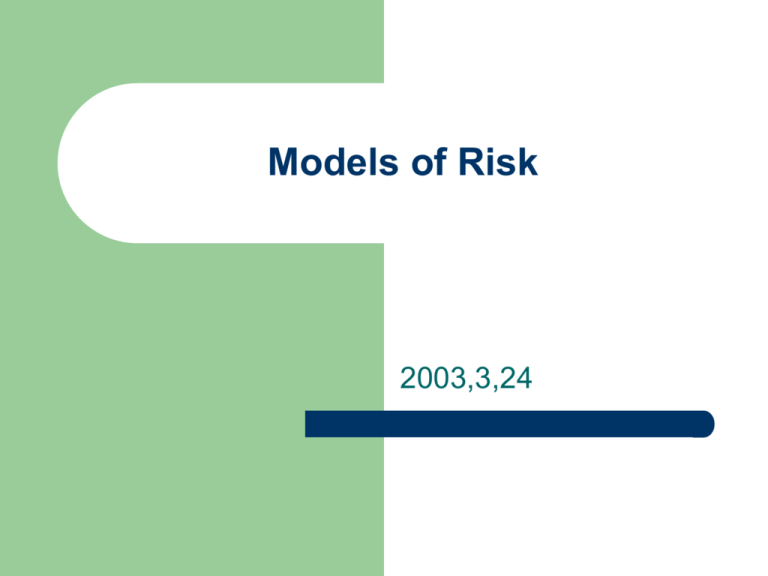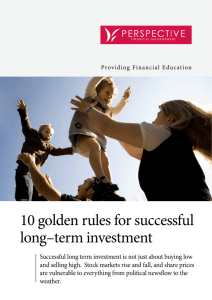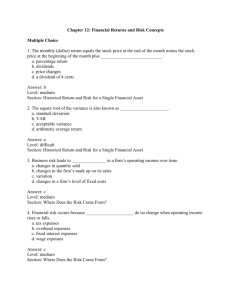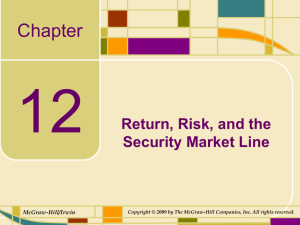Notes 3
advertisement

Models of Risk 2003,3,24 What is risk? Risk: to expose to hazard or danger Risk = riscare (dare to do something) Risk = 危機 (danger and opportunity) Goal of finance (investment) To ensure that when an investor is exposed to risk, there will be an “appropriate” reward for taking the risk. Characteristics of risk and reward models Provide a measure of risk that applies to all assets and not be asset-specific Delineate those type of risk that are rewarded and those that are not, and should give a rationale for the delineation Based on standardized risk measures ( to conclude the asset involve above-average or below-average risk) Translate the measure of risk into a rate of return that the investor can expect or demand as compensation for bearing the risk It should work well not only as an explanation of past returns, but also as a prediction of future expected returns. How risk is viewed in finance Defined the risk in terms of the distribution of actual returns around an expected return differentiate between risk that is specific to one investment or a few investments, and risk that affects a much wider cross section of investment. Measure risk Riskless investment: default-free bond, the actual return is the expected return. Risk investment: stock, the actual return will almost certainly NOT be equal to the expected return. Symmetric? The spread of actual returns around the expected return is captured by the variances or standard deviation of the distribution. The bias toward positive or negative returns is captured by the skewness of the distribution. The shape of the tails of the distribution is measured by the kurtosis of the distribution. (fatter tails lead to higher kurtosis) Symmetric and normal: expected return and variance Symmetric : same standard deviation, chose higher expected return Neither symmetric nor normal : expected return, variance, positive skewness, and then lower kurtosis (lower likelihood of jumps) than higher kurtosis (higher likelihood of jumps). Investors tend to trade off good moment (higher expected returns and more positive skewnwess) than bad moment (higher variance and higher kurtosis) Capital asset pricing model (CAPM) explicitly requires that choices be made only in terms of expected returns and variances. Utility function =? Disney (Jan 1992 – Dec 1996) SD in monthly returns = 6.14% Variance in monthly returns = 37.66% (?) annualized SD = 6.14 12 21.26 (?) annualized variance = 37.66 12 452 Rewarded and Unrewarded Risk Firm-specific risk Market risk The components of Risk Project-specific risk competitive risk Industry-specific risk: technology risk, legal risk, commodity risk International risk: currency Market risk: macroeconomic factors Diversification Reduces or eliminates firm-specific risk diversification Why marginal investor is assumed to be diversified? Risk increase if undiversified. Diversified investors are willing to pay higher price to reduce risk. The asset will, over time, will end up being held by diversified investors. Measuring Market Risk Risk comes from the distribution of actual returns around expected return. Risk should be measured from the perspective of marginal investor who is well diversified. (spot price) Methods for measuring risk (Asset Pricing) Capital asset pricing theorem (CAPM) Arbitrage pricing theory (APT) Multi-factor models Regression models CAPM Assumptions: diversification is attractive Real world: tractions cost and monitoring cost, reduced risk is smaller when the number of stock is larger. We believe we can find under-valued stock. Market portfolio: A portfolio that contains all traded assets in the market. Beta CAPM Implications for investors: If all investors hold the identical market portfolio, how do investors r? Answer: Asset Allocation on riskless and risky asset. Measuring the market risk of an individual Asset: Beta of an asset i = Covariance of asset I with market portfolio/variance of portfolio Beta of market portfolio=1 Expected return E ( Ri ) R f i [ E ( Rm ) R f ] The CAPM in Practice (three inputs) Riskless asset: may dependent on time period risk premium: difference of expected return (historical return) of risky asset and riskless return Beta: Covariance of risky asset and market portfolio divided by the variance of market portfolio (estimated by historical data) The Arbitrage Pricing Model (APM) Assumption: If there are two portfolio has the same exposure of risk but offer different expected returns, the investor will buy the portfolio with higher return. This action will adjust the expected returns to equilibrium. Risk=Market +Firm-specific m is the marketwise component of unanticipated risk is the firm-specific component Return model: r E ( R) m Market Risk In CAPM, the market risk is capture by market portfolio. In APM, the market risk is coming from economical fundamentals, gross national product, interest rates, and inflation, and it measures the sensitivity of investments to these changes with factor betas. Market Risk m 1F1 2 F2 n Fn Where j the sensitivity of the investment to unanticipated changes in factor j F unanticipated changes in factor j j The Effects of Diversification The returns of portfolio will not have firmspecific component of unanticipated returns. Rp ( w1R1 wn Rn ) ( w11,1 wn 1,n ) F1 ( w1n,1 wn n,n ) Fn Expected Returns and Betas The beta of a portfolio is the weighted average of the betas of the assets in the portfolio, in conjunction with absence of arbitrage, leads to the conclusion that expected returns should be linearly related to betas. Expected returns and Betas Portfolio Expected return Beta A 20% 2.0 B 12% 1.0 C 14% 1.5 E(Rj ) Rf of factor j can be viewed as risk premium E ( R) R f 1[ E ( R1 ) R f ] n [ E ( Rn ) R f ] APM in practice Estimates of each of the factors betas and factor risk premium.







